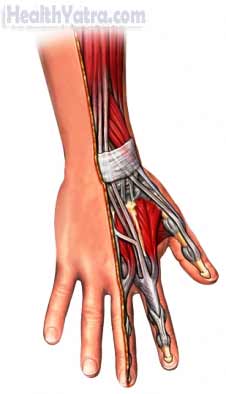Definition
Tendons are responsible for connecting muscles to bone. The fingers have tendons that run from the forearm through the finger. The extensor tendons are located on the back of the hand and fingers. They let you open your hand and straighten your fingers. An extensor tendon injury is a cut or tear to one of these tendons. When they are damaged, you can lose the ability to extend your hand and/or finger(s). Two common extensor injuries are:
- Mallet finger —the tendon is affected at last joint on the finger, usually from a jammed finger
- Boutonniere Deformity —the tendon is affected at the middle joint, usually caused by an arthritis-like condition

If you suspect that you have this condition, contact your doctor right away. The sooner you start treatment, the better the outcome.
Causes
Extensor tendon injuries may be caused by:
- A cut or laceration to back of hand or fingers
- Broken bones
- A crush injury
- An open wound or cut
- Jamming a finger
- Arthritis
- Nerve compression
Risk Factors
These factors increase your chance of an extensor tendon injury. Tell your doctor if you have any of these risk factors:
- Participate in certain sports
- Basketball
- Football
- Arthritis
Symptoms
If you have any of these symptoms, do not assume it is due to an extensor tendon injury. These may be caused by other conditions. Tell your doctor if you have any of these symptoms:
- Unable to open hand or fingers
- Pain
- Numbness or weakness
- Cut to back of hand or fingers
- Jammed finger
Diagnosis
Your doctor will ask about your symptoms and medical history. A physical exam will be done. During the exam, you will be asked to bend and straighten your fingers. Your doctor will also check your fingers for sensation, blood flow, and strength. You may be referred to a hand surgeon or an orthopedist (doctor who specializes in bones).
Your doctor may order the following test:
- X-ray
Treatment
Talk with your doctor about the best plan for you. Depending upon the type of injury, you may require surgery. Surgery may be scheduled immediately or within several days.
Treatment options include the following:
Medications
Depending upon the type of injury, you may receive antibiotics to prevent infection.
Surgery
Tendons that are cut or ruptured require surgery. The hand surgeon may sew the tendon back together. A pin may need to be inserted through the bone to form a type of inside splint.
Rehabilitation
After surgery, you will be given a splint to protect your hand. Your doctor will tell you how long to wear it. It may be up to two months.
A physical therapist will work with you for several weeks to regain your strength and range of motion. Right after surgery, movement will be limited. This will allow your hand to heal.
Splinting
Some extensor tendon injuries are treated with a hand splint. Splints are worn until healing has occurred. This is usually several weeks.
Prevention
Extensor tendon injuries are typically caused by accidental injuries. There are no known prevention guidelines for this injury. But, the deformities caused by these injuries may be prevented by taking certain measures, like splinting the finger or undergoing surgery.
